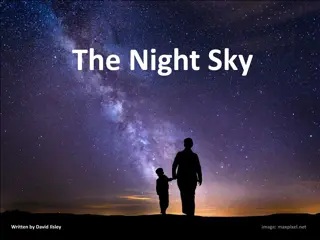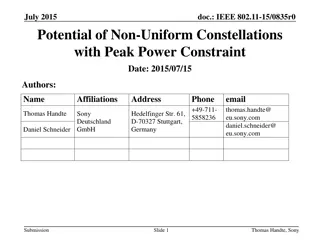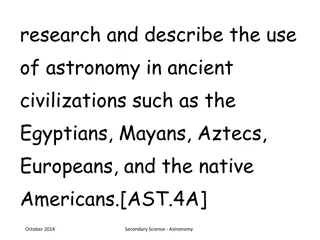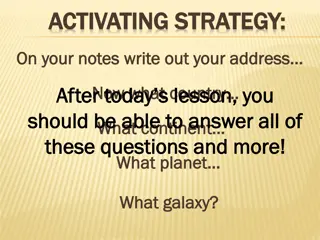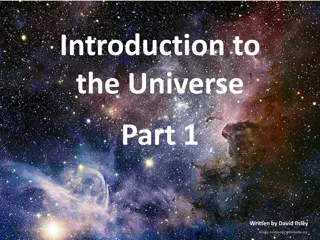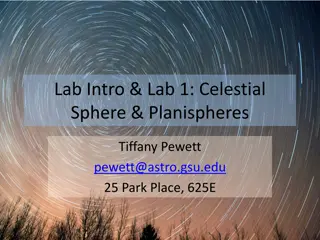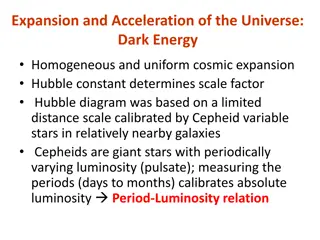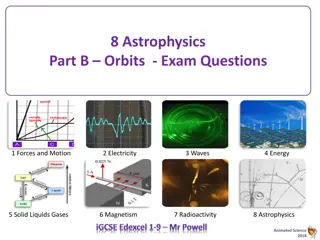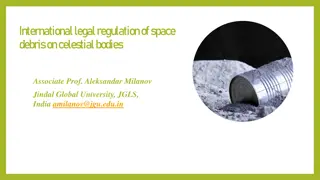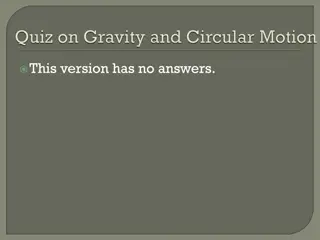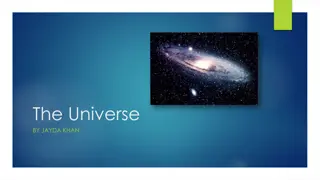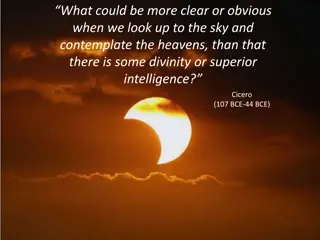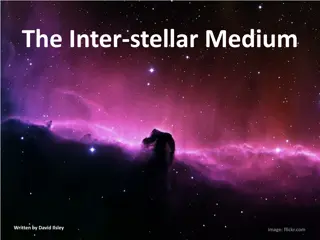Understanding Celestial Bodies and Constellations in the Universe
Explore the fascinating world of celestial bodies in the universe, including stars, galaxies, planets, and constellations. Learn about the formation of stars, the structure of galaxies like the Milky Way, and how constellations have been observed and named throughout history. Discover the significance of the Pole Star and iconic constellations such as Ursa Major and Orion. Delve into the wonders of the solar system and our place in the vast cosmos.
Download Presentation

Please find below an Image/Link to download the presentation.
The content on the website is provided AS IS for your information and personal use only. It may not be sold, licensed, or shared on other websites without obtaining consent from the author. Download presentation by click this link. If you encounter any issues during the download, it is possible that the publisher has removed the file from their server.
E N D
Presentation Transcript
The bodies we see in the sky from earth are called heavenly bodies or celestial bodies. They include the stars, planets, comets and the moons. Stars: Stars are huge balls of very hot gaseous matter. They are self-luminous celestial bodies that emit heat and light. The sun is the star nearest to the Earth. Stars are formed from huge clouds of dust and gas. When the centre of the cloud becomes thicker and denser, it starts shrinking into a thick disc and starts spinning rapidly. The centre of the spinning mass becomes hotter and hotter. Finally, a chain of reactions occurs where huge amount of energy , in the form of heat, light and other radiations, are released into space, and a star is formed.
Stars are found in very large clusters or groups. These clusters are called galaxies. A galaxy consists of groups of stars, dust, gas and other matter, bound together by a force called gravity. There could be several million stars in a galaxy. All the galaxies together make up our universe. There are hundreds of billions of galaxies, with more getting formed every moment. Our galaxy is the Milky Way. It is known as the Aakash Ganga in Hindi.
The Constellations Some of the stars in the sky appear to be arranged in recognisable patterns, like animals, people, and different objects. These patterns stars appear to make in the sky are called constellations. Since ancient times, hundreds of constellations have been identified in the sky, of which scientists accept 88 names now. Two of the more easily recognisable constellations are Ursa Major and Orion. Other include Canis Major( The Great Dog), Leo ( the Lion) and Taurus (the Bull).
Ursa Major is also known as the Great Bear or the Big Dipper because it takes the shape of a large ladle. While the three stars form the handle, four stars form the bowl. If you draw a straight line joining the first two stars of the bowl and extended it due north , the line points to the Pole Star or the North Star( Dhruva nakshatra). The Pole Star is always found directly over the northern horizon. During ancient times sailors and other travellers used the Pole Star to find directions at night. Orion is shaped like a hunter with a raised club.
The sun and the various objects that move around it , together form the Solar System. Solar means of the sun . The sun occupies the central position in the solar system and all the other celestial bodies in the system revolve around it. Early astronomers thought that the sun and all the planets revolved around the Earth. This belief was supported by the geocentric ( meaning centred around the Earth) theory put forward by Claudius Ptolemy in 140 CE. After years of scientific observation, Nicolaus Copernicus in 1543 CE , put forwarded a new model of the Solar system, with the Sun at the centre and the Earth, the Moon and the other planets revolving around the Sun. This new theory was known as the heliocentric or Sun centric theory.
The Sun The Sun is almost 5 billion years old. The gravitational field of the Sun holds the entire Solar System together. It is made up of hot gases, mainly helium and hydrogen. The surface temperature of the Sun is 5700 oC. The heat from the Sun , after travelling 149 million km, the distance from the Sun to the Earth , is still strong enough to fry an egg in the Sahara Desert. At the centre of the Sun , the temperature is about 15 million oC. The sun s diameter is 1,392,000 km. It is 109 times bigger than the Earth. The distance of the Moon from the Earth is less than half the diameter of the Sun. however , there are Stars which are hundreds of times bigger than the Sun.
The Sun is the primary source of heat and light for living beings on Earth. Life on Earth is possible because of its optimum distance from the Sun, that is, The Earth is neither too far from the Sun nor too close to it. Sunlight reaches the Earth in about 8 minutes. Light year: Light travels at a speed of 300,000 km per second. The distance travelled by light in a year is called a light year.
The Planets A planets is a celestial body that orbits or goes around a star. They are spherical in shape and non luminous. Instead , they reflect the light of the Sun that falls on them. Every planet spins on its own axis. This is called rotation. One rotation is referred to as a planet day. Planets also move around the Sun along a fixed elliptical path of their own called an orbit. One complete orbit around the Sun is called a revolution or Planet year.
There are eight major planets in the solar system. They are Mercury, Venus, Earth, Mars, jupiter, Saturn, Uranus and Neptune. When the Sun was formed , the colder outer parts of the disc broke up to form the four giant planets Jupiter, Saturn, Uranus and Neptune. They are mainly made of gas and are cold. They are called the outer planets or the Jovian planets. In the warm inner part of the disc , rocks and metal lumps came together to form the inner planets or the terrestrial planets Mercury, Venus, Earth and Mars. There is an easy way to remember the planets in the order of their distance from the Sun. Just remember : My Very Elegant Mother Just Served Us Noodles. The International Astronomical Union declared that Pluto as a Dwarf Planet.
Dwarf Planet: A planet should not have any other object of its own size in its neighborhood other than its own satalites. Pluto shares its neighborhood with several other bodies called Plutinos. Hence , it was classified as dwarf planet.
The Earth The earth is a unique planet , as it is only here that life has been formed. It is the third planet from the Sun and the largest among inner planets. It is flattened at the poles and therefore , its shape is referred to as a spheroid. About two- thirds of the Earth is covered by water. Therefore it is known as Blue Planet. Here water is found in all three states( Solid, liquid and gas) in nature. The Earth is surrounded by a blanket of air called the Atmosphere. The Earth rotates on its axis, and revolves around the Sun. The rotation of the Earth causes day and night, the revolution of the Earth causes the seasons.
The favourable conditions that facilitates life on the Earth are: Optimum distance from the Sun. An average surface temperature of 14oC. Suitable seasons and weather conditions. Adequate availability of liquid water. The presence of an atmosphere that protects living things from harmful ultra-violet radiations from the Sun.
Is The Earth Flat? The ancient astronomers believed that the Earth was flat. But over the years it was proved that the Earth is like a sphere. Explorers who set out on voyages around the world came back to the place they started from. This could happen only if the world was round. The shadow cast by the Earth on the Moon during a lunar eclipse is circular. The length of the shadow cast by a stick at 12 noon increases as we keep going further north or south of the equator. If the Earth were flat, the shadow cast by the stick would be the same everywhere.
The images of Earth taken from space show that it is spherical. When we see a ship coming to a port, we first see the mast or top of the ship, and then gradually the base of the ship. If the Earth were flat, we would see the whole ship at once.
The Moon The celestial objects that revolves around planets are called their natural satellites or moons of the planets. Except Mercury and Venus , all the other planets have moons. The Moon is the only satellite of the Earth. It shines because it reflects the light of the Sun. It is about 384,400 km away from the Earth. It takes 27 days and 8 hours to complete one revolution around the Earth. Since the time taken for the Moon to rotate is also the same , we always see the same side of the Moon.
There is no air on the Moon. But recently minute amounts of water has been discovered. It gets hot (100oC) in the day and cold(-150oC) in the night. It has an uneven , rough and rocky surface with huge craters. The shape and position of the Moon as seen from the Earth, varies each day. We have a full moon night( Purnima) about once a month. The full moon wanes or gets smaller , till a fortnight from the full moon night, it cannot be seen from the Earth. This is called the new moon night(amavasya). On 29 July 1969, Neil Armstrong became the first human to land on the Moon. He and his co- astronauts , Edwin aldrin and Michael Collins, brought back a wealth of information about the Moon.
Asteroids Asteroids are celestial bodies that revolve around the Sun between the orbits of Mars and Jupiter. Scientists believe that these are parts of planets which exploded millions of years ago. They could also be matter that was left over after planets were formed. They are also known as planetoids.
Meteors Meteors are pieces of rock moving at tremendous speeds around the Sun. When these rock masses come near the Earth, they are pulled in by the Earth s gravity. As the meteoroids enter the Earth s atmosphere, they begin to glow as a result of heating due to friction. The streaks of light that burning meteoroids produce as they fall to the Earth are called Meteors or Shooting stars. The partly burnt fragments of rock materials sometimes fall on the surface of the Earth causing huge dents or craters. These rock fragments are called meteorites. We can see such craters in Arizona, USA.
Space Research Today space research has become an integral part of global development. New discoveries are being made about the nature of space and the formation of the universe every day. One of the best known international space research centres in the world is NASA in the USA. In India , space research is conducted by the Indian Space Research Organisation(ISRO)



